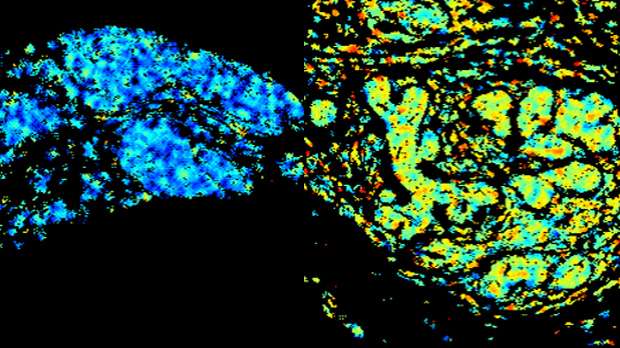Imaging technique could help focus breast cancer treatment

Cancer Research UK scientists have used imaging techniques as a new way to identify patients who could benefit from certain breast cancer treatments, according to a study published in Oncotarget.
The team at King's College London, in collaboration with scientists at the CRUK/MRC Oxford Institute for Radiation Oncology, used fluorescence lifetime imaging to confirm if they have joined together.
Fluorescent lifetime imaging is a technique that can accurately measure the distance between two protein molecules. In this study the researchers measured the distance between HER2 and HER3 proteins in breast cancer cells from patients.
The researchers think that patients whose imaging results show that these proteins have bonded together could benefit from HER2 targeted treatment, regardless of whether their tumour has high levels of HER2.
HER2 is a protein which can cause cancer cells to grow. HER2-positive breast cancer cells have high levels of the protein and can be targeted with drugs that block its effects and stop the cancer from growing – drugs being used now include Herceptin and Tykerb. Patients who could benefit from these drugs are identified by testing their cancer cells to see if they show high levels of the HER2 protein.
But this imaging technique, carried out in tumour cells, could pick up additional patients in the future who would respond well to HER2-targeting drugs. It could also confirm which patients may not be suitable for these treatments.
Lead author, Professor Tony Ng, at King's College London and University College London, said: "This imaging technique could help us pick up patients who might benefit from these drugs but have previously been overlooked.
"Using this test, we should be able to predict which drugs won't work in patients and avoid prescribing unnecessary treatments – putting the drugs that we've got to better use. The next step is to run clinical trials to see if this test could help patients.
"We hope that one day it could not only improve treatment for breast cancer but also for other cancers – including bowel and lung cancer."
Nell Barrie, senior science information manager at Cancer Research UK, said: "There are more than 50,000 new cases of breast cancer each year but thanks to advances in research, more people survive the disease than ever before. This research could eventually give doctors another way to personalise treatment so that patients receive the drugs that are most likely to help them."
More information: Vojnovic, B, Barber, P, Nguyen, L et al., (2016). HER2-HER3 dimer quantification by FLIM-FRET predicts breast cancer metastatic relapse independently of HER2 IHC status. Oncotarget. ora.ox.ac.uk/objects/uuid:8585 … 8f-b167-6269689247bd

















